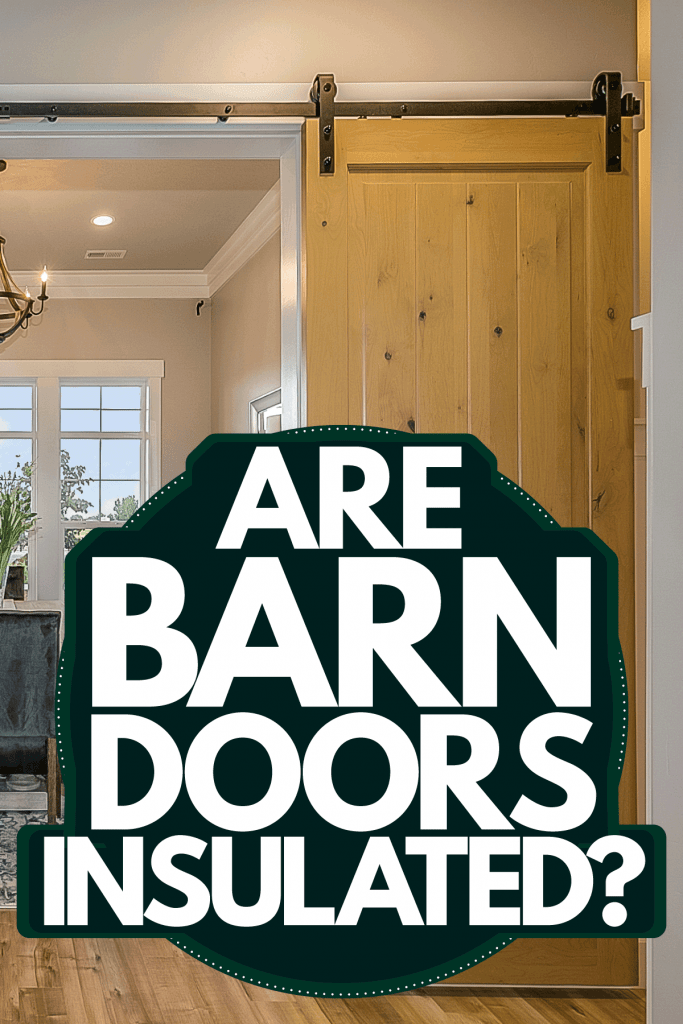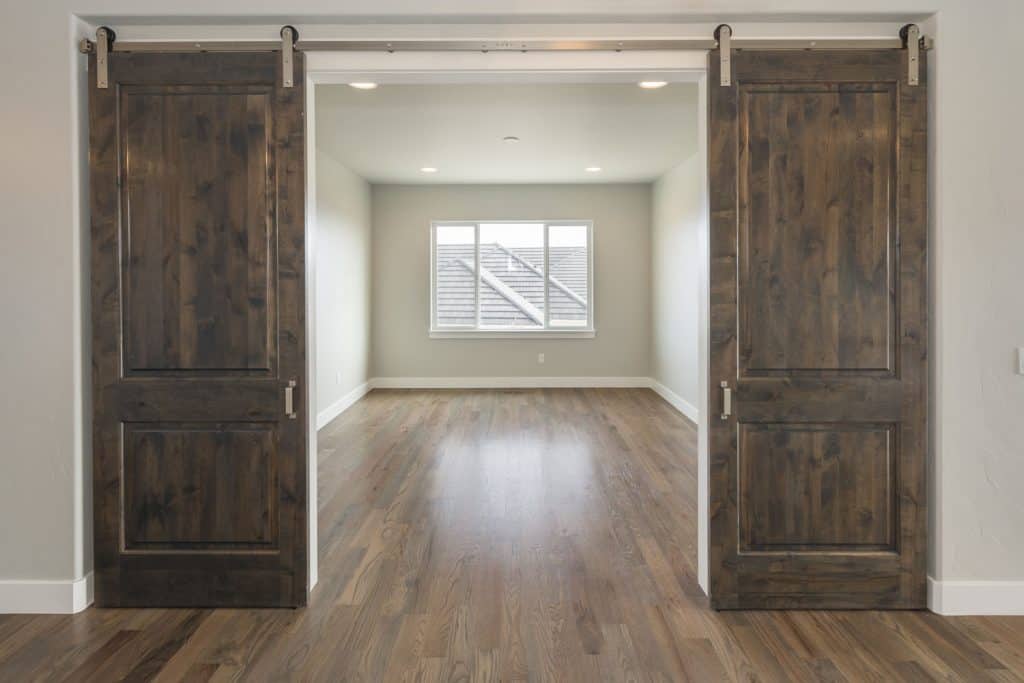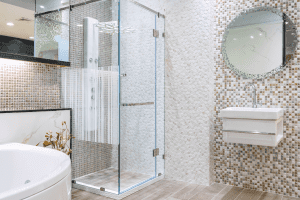Over time, the design and composition of barn doors have evolved to give homeowners more options. Given the sustained interest in barn doors over the years, can you purchase insulated barn doors now? We looked for the answers, and below is what we found out.
There are custom-made barn doors that have built-in insulation. However, to fully insulate your barn door once installed, you need to protect the top, bottom, and sides of the door. To do this, you will have to purchase additional seals to cover all sides.
Other than keeping the elements at bay, there are other advantages of insulating your barn door. Keep on reading to learn more.

Why do you insulate your barn door?
Below are the reasons why you should consider insulating your barn door, especially those installed as your exterior door:
For Building Code Compliance
You need to insulate your barn door to comply with your local building codes. It is now required that most exterior doors be weather-stripped. Not only should they withstand rain but also extreme weather conditions.
For Efficient Use of Energy

Barn door insulation keeps unwanted cold or heat outside while maintaining a controlled internal environment. Overall, the goal is to achieve interior thermal comfort and an energy-efficient internal climate.
A fully insulated barn door allows efficient use of energy by keeping the internal environment balanced and keeps out unwanted creatures from getting in.
New constructions nowadays have increasingly focused on sustainable designs. And one particular measure that is being used to rate this is the Leadership in Energy and Environmental Design (LEED).
To Keep Animals Out
Insulation can also help to keep unwanted animals out. Small animals like birds or rodents can easily make its ways through the top, bottom, and sides of the barn door. By ensuring that you seal off access points into your house, you keep them at bay and the microorganisms that they carry along with them.
To Keep Noise Down
Although barn doors are not top choice if you need privacy, adding insulation can help keep the noise down as the seals can help tone down the noise coming from the outside or adjacent rooms within the house.
Insulation is helpful when you're working from home. You are able to maintain the privacy of your conversations and those who live with you in the house.
Why barn doors may not be the best choice for exterior doors
To keep things in perspective, below are some potential disadvantages of using barn doors:
Additional Cost
Whether you buy an insulated barn door or you plan to do it yourself, there will be additional expenses to install the insulation and maintain it.
Wider Gap Between The Door and The Wall
You may have to widen the gap to accommodate the insulation that you would place along the door's sides, top, and bottom. The hardware associated with insulation to accommodate the gap should also be considered.
Despite the drawbacks above, you are still better off choosing an insulated door or adding insulation to your barn door for the reasons and advantages previously discussed.
How do you insulate a barn door?
Most barn doors would need to be insulated from the top, bottom and sides. You would also need to install a rain guard on top of the door for external barn doors to keep moisture out. This is particularly crucial to seal the barn door and the flashing area so that the wood will not rot.
When insulating your barn door, consider the following points:
- Ensure that the sides are sealed off. You would need to use a seal to close off the edges and thus close the gap.
- Install brush-type seals for the top and bottom portion of your barn door. Not only do these seals ward off cold drafts, but they also allow the door to glide easily.
- Install latch inside the barn door – for practical reasons, a latch can maintain your seals to adhere to each other tightly.
Do barn doors close tight?
There will always be a gap between the wall and the barn door to accommodate a good glide. The track mechanism would need a clearance space to ensure that the barn door will be installed correctly and supported accordingly.
However, since most of the entries are now custom-built, you would expect the sides to close comfortably but would still not completely shut. An excellent way to ensure that they remain closed is to install a latch to help keep the sides together.
Another feature that can ensure that the doors close tightly is installing a ceiling mechanism with locking or catching parts. But any time the door becomes off track, misalignment may occur, and the door may not seal off completely.
How far out from the wall does a barn door hang?
Standard tracks will make your door stick out from the wall by about one ¾ inch, which can stretch up to 3 ¾ inches if you add a baseboard and trim.
Another dimension to consider is the headroom for your barn door. If you want to know more about how to hang your barn door, you can read through our post, Can A Barn Door Be Hung From The Ceiling?
How do you fill the gap between barn doors and walls?
There are many options now to fill the gap between the barn door and the wall. We have listed a few here:
- Add seals - you can either use shower seals or weatherstrips to seal off extra space between your door and the wall. Soundproof foam can also be used depending on the location of the door. Alternatively, a door sweep or wooden seal may also be considered.
- Use an L-shaped side rim - the side rim can easily cover up the open sides.
- Opt to use a more oversized barn door that can completely cover the opening, especially if you're only using a standard track with no baseboards added.
Should a barn door be wider than a doorway?
A barn door should be wider than the doorway. The general rule is that it should allow a 1-inch overlap on both sides. However, some materials have mentioned allowing gaps up to 6 inches of coverage on both sides.
Additionally, there should at least be a 1-inch allowance on top. Thus, if you lack horizontal space to accommodate a wider door, then a barn door may not be an option.
The door would also require a track for it to hang from and glide through when being used. And generally, the rule is that the path should be twice as long as your door. The path should also be well anchored to support the door's weight when in a static position and when it's being used.
Are barn doors noisy?
Depending on the track system that you use, a barn door may be noisy. A full metal track may give off more sound when the door is being pulled than one with rubber rollers installed.
Consider the weight of the door that you would like installed. A misappropriated track can also add to the noise.
The need for soundproofing is also a drawback of the barn door as there are gaps on all sides. The best way to lessen the noise is to soundproof it.
Nowadays, many available seals can do the trick. However, this may add to the cost. An estimate is that you can easily spend over $4,000 for a project that includes the door, hardware, and installation alone.
In Summary
Barn doors may be the perfect choice to add to your space, especially if you would like to separate two large areas in the house and leave room for flexibility when you need to convert it back. But it is not the best choice for soundproofing or privacy.
The good news is that there is now additional hardware available to lessen the noise. Moreover, there are now more custom doors open with built-in insulation that can allow noise reduction. Although everything will have an additional cost, it may all be worth it when you see how barn doors can transform the place.
In case you would like to know more about barn doors, click on the links below:



